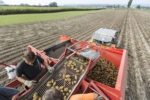The European bison, a species that differs slightly from its north American cousin, died out in Europe. Now it is to be reintroduced in Switzerland. Can a densely populated country tolerate such a large wild animal?
Otto Holzgang, a biologist, stretches one arm out and puts his thumb in front of a bison grazing on the slope above us. “If my thumb covers the whole animal, we are far enough away,” he says.
We are standing a little more than 50 metres away from the bison, the official safety distance. Visitors inside the enclosure are not allowed to go any closer.
Earlier, Holzgang, who runs the reintroduction project “Wisent Thal”, had located the animal electronically. The enclosure in Welschenrohr, roughly 65km north of Bern, is 50 hectares in area, the equivalent of 70 football fields, and encompasses meadows and woodland. Two animals wear collars with GPS transmitters that communicate their location every hour, making it easy to find the rest of the small herd. The data shows they are often in the woods.
The bison come from the Zurich Langenberg Wildlife Park, where they had no access to woodland. They have been in Welschenrohr since September 2022. It took them more than three months to scout out the entire enclosure, Holzgang says. They seem to feel comfortable in their new home. And one day they might live in near-freedom.
The reintroduction of the European bison to areas where it had become extinct reflects a worldwide trend. Its presence is said to promote biodiversity, among other benefits. Poland is playing a leading role in Europe, followed by other countries in Eastern Europe.
We interrupt the interview briefly as a couple on a walk open the gate to the enclosure. A path leads directly through it. Do these wild animals, which can measure 1.90m-high at the shoulder, pose no danger to them? Holzgang, who calls the bison “gentle giants”, says they are not a threat.
“The bison have already noticed them,” he says. “They are extremely observant. They notice everything.” But because the couple pose no danger, they are continuing to graze calmly. “This is really beautiful to watch,” says Holzgang, as the couple walk on.
On our May visit, the herd consisted of five animals. The pregnant cow gave birth to a calf in early July: “the first bison calf in Switzerland for 1,000 years”, as the headlines announced. Today, the herd consists of a leader cow, two other cows, two calves and a bull.
Descended from just 12 animals
The bison was nearly wiped out in Europe. In the early 20th century, there were still about 800 free-ranging bison, mainly in the wilds of Eastern Europe, Holzgang says. In 1919, the last wild lowland bison was shot in Poland.
According to Monica Vasile, a specialist in environmental history at the University of Maastricht in the Netherlands, a plan to protect the bison was conceived in Europe in 1924.
At that time, there were just 54 European bison in captivity – among these, only 12 reproduced. All the European bison living today are descended from these 12 animals. The first reintroductions into the wild took place in 1952.
Vasile has been studying the reintroduction of the European bison in the Romanian Carpathians. “Reintroductions are very complex projects, which require expertise at many levels to ensure the well-being of the animals, reducing their stress levels, as well as supporting them towards self-reliance,” she writes in an email.
It is important for project managers “to remain open to adjusting their strategies as needed”, she says. In recent times, it has become apparent that European bison reintroduction practices have slowly “shifted away from a controlling approach to reintroductions inspired by livestock breeding, and towards a hands-off rewilding approach,” she adds.
“A very thoughtful communication process with local people has to be considered regardless of the size and of the animal.”
Impact on the tree population
By now, the bison have moved a little further away from us and we can take the path up into the woods. We want to get an idea of how the project is being scientifically monitored.
Researchers from different universities and institutes come here frequently to take samples or measurements that give insights into the bison’s impact on the environment.
Today, two botany researchers are in the woods. They are measuring the impact of browsing on young trees. The researchers cannot determine which animal was responsible for browsing damage, so it is important to have a before-and-after comparison.
Measurements are always taken at the same points in the enclosure. A random grid defines these 120 samples; every 50 metres there is a measuring point. Nicole Imesch, a biologist, records two tree shoots from each height category, and then compares them with data from earlier measurements.
She had already been in this section of the woods twice before the bison were introduced here. “The impact of roe deer and chamois is already very significant, even without the bison,” she says.
Not popular with everyone
“As a trial balloon, it has been really well launched,” Daniel Hegglin, a wildlife biologist, says of the reintroduction project. Hegglin is the managing director of the Stiftung Pro Bartgeier (Pro-bearded vulture foundation) and is not involved in the bison project. He is considered an expert on reintroductions.
Three conditions must be met for a reintroduction, he says: first, a prior, comprehensive evaluation; second, scientific monitoring; and third, acceptance by the population.
On the third point, Welschenrohr has problems. A contact group with members of the public exists, but according to media reports, there are repeated disagreements, especially with farming representatives. This is perhaps partly because a similar project in Germany failed.
“There are some people who are fervent advocates,” says Holzgang when asked about these tensions. “There are others who think, ‘yes it's nice, but we don’t need it’. And, of course, there are the people who are dead against it, as there are for every project.”
So the project leaders are glad when children come to visit. School classes have been following the bison’s progress from the outset. That has led to children later taking their parents to visit with them. “The children actually did some educational work too,” Holzgang says.
Bison as promoters of biodiversity
Karin Hindenlang, the director of the Zurich Langenberg Wildlife Park, is one of the initiators of the bison project. Bison have been living in the park at Sihlwald, south of Zurich, since 1969. She is pleased with the trial and hopes to gain new insights into the animals and their impact on the landscape, she writes in an email.
“They shape vegetation through their grazing behaviour and create a diverse, species-rich mosaic landscape of sparse forest and meadows,” Hindenlang says.
The park also participates in European conservation breeding programmes, in which zoos selectively breed animal species at risk of extinction and maintain as broad a genetic base as possible. The bison at Welschenrohr have a studbook for this reason.
Freedom in sight?
The bison enclosure is to be expanded to 100 hectares in autumn 2024. For the purpose of the trial, it is currently surrounded by two different types of fencing. One is an electric fence with three wires at heights of 0.5m, 1m and 1.5m. The other, installed in certain areas, is a wire fence 2.5m high.
This ensures that other wild animals can enter the enclosure. As if to illustrate that this works, a deer suddenly appears at the edge of the forest, inside the enclosure. “We have seen deer close to the bison inside the enclosure from day one,” Holzgang says.
After three years of using the large enclosure, those responsible for the project have to deliver a report. What is the impact of the bison? To what degree are they accepted by the population? What is the sustainability from an economic point of view with regard to forestry and agriculture? Then the canton will decide whether to continue the project.
The second phase of the project phase would mean semi-liberty for the herd. The fences would be dismantled and the bison would be able to roam more or less freely.
“They would still be electronically monitored and would still belong to the association,” Holzgang says. This means that the association would have to pay all damages and be responsible if there are problems with the animals, be it due to illness or because they become aggressive.
The question of whether the animals can eventually be released into the wild is still open. Ultimately, the canton where the herd is located, the canton of Solothurn, would have to submit an application to the environment ministry.
Now the herd has moved a little closer to us, almost unnoticed. “We are too close now,” Holzgang says. “Or rather, that animal has come too close to us. Let’s wait and see what the cow does. If she just moves on, that's okay. If she goes in our direction, then we retreat.” The bison cow eventually steps away calmly. She is a gentle giantess.
Edited by Sabrina Weiss. Translated from German by Catherine Hickley/gw.
More: SWI swissinfo.ch certified by the Journalism Trust Initiative
Full story here Are you the author? Previous post See more for Next postTags: Environment,Featured,newsletter























